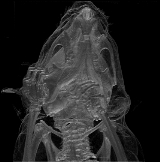
Skull
Overview
The skull is a bony
structure in the head
of many animal
s that supports the structures of the face
and forms a cavity
for the brain.
The skull is composed of two parts: the cranium and the mandible
. A skull without a mandible is only a cranium. Animals that have skulls are called craniates
. The skull is a part of the skeleton
.
Functions of the skull include protection of the brain
, fixing the distance between the eyes to allow stereoscopic vision, and fixing the position of the ears to help the brain use auditory cues to judge direction and distance of sounds.
Bone
Bones are rigid organs that constitute part of the endoskeleton of vertebrates. They support, and protect the various organs of the body, produce red and white blood cells and store minerals. Bone tissue is a type of dense connective tissue...
structure in the head
Head
In anatomy, the head of an animal is the rostral part that usually comprises the brain, eyes, ears, nose and mouth . Some very simple animals may not have a head, but many bilaterally symmetric forms do....
of many animal
Animal
Animals are a major group of multicellular, eukaryotic organisms of the kingdom Animalia or Metazoa. Their body plan eventually becomes fixed as they develop, although some undergo a process of metamorphosis later on in their life. Most animals are motile, meaning they can move spontaneously and...
s that supports the structures of the face
Face
The face is a central sense organ complex, for those animals that have one, normally on the ventral surface of the head, and can, depending on the definition in the human case, include the hair, forehead, eyebrow, eyelashes, eyes, nose, ears, cheeks, mouth, lips, philtrum, temple, teeth, skin, and...
and forms a cavity
Cranial cavity
The cranial cavity, or intracranial space, is the space formed inside the skull. The brain occupies the cranial cavity, which is lined by the meninges and which contains cerebrospinal fluid to cushion blows....
for the brain.
The skull is composed of two parts: the cranium and the mandible
Mandible
The mandible pronunciation or inferior maxillary bone forms the lower jaw and holds the lower teeth in place...
. A skull without a mandible is only a cranium. Animals that have skulls are called craniates
Craniata
Craniata is a proposed clade of chordate animals that contains the Myxini , Petromyzontida , and Gnathostomata as living representatives...
. The skull is a part of the skeleton
Skeleton
The skeleton is the body part that forms the supporting structure of an organism. There are two different skeletal types: the exoskeleton, which is the stable outer shell of an organism, and the endoskeleton, which forms the support structure inside the body.In a figurative sense, skeleton can...
.
Functions of the skull include protection of the brain
Brain
The brain is the center of the nervous system in all vertebrate and most invertebrate animals—only a few primitive invertebrates such as sponges, jellyfish, sea squirts and starfishes do not have one. It is located in the head, usually close to primary sensory apparatus such as vision, hearing,...
, fixing the distance between the eyes to allow stereoscopic vision, and fixing the position of the ears to help the brain use auditory cues to judge direction and distance of sounds.
Unanswered Questions

